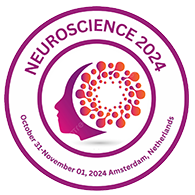36th World Neuroscience and Neurology Conferences
Amsterdam, Netherlands
Dr. Ramachandran Muthiah
President of Neuroscience , USA
Title: Neurocognitive dysfunction in Rasopathies
Biography
Biography: Dr. Ramachandran Muthiah
Abstract
RASopathies are resulting from germline mutations of the protooncogene HRAS and affect SHP2, SOS1, RAS, RAF and MEK proteins. Dr. White says. a group of related disorders including Costello syndrome, Noonan syndrome (NS), cardiofaciocutaneous (CFC) syndrome, and neurofibromatosis 1 (NF1), caused by abnormal functioning of the Rasâ€mitogenâ€activated protein kinase (RAS/MapK) pathway that controls cell proliferation, differentiation, survival and its dysregulation causes clinically overlapping genetic disorders, called as ‘Rasopathies’. In this pathway, Ras, a GTPase, transmits extracellular signaling from receptor tyrosine kinases to two serine/threonine kinases (Raf and MEK) and, finally, to the activation of MAPKs. Rasopathies are developmental disorders characterised by postnatal growth retardation with delayed skeletal maturation, psychomotor retardation, cutis laxa, and acanthosis nigricans. In 2009, gain-of-function missence mutation in SHOC2, C4a> G(Ps2g), identified in NS-like syndrome with loose anagen hair, severe intellectual disability, hypernasal voice and skin abnormalities.The splicing efficiency of activating HRAS mutations can determine the rasopathy phenotype. Gene correction of these germline mutations to restore normal protein functions is anticipated as a new therapeutic option. Neurocognitive involement is a common feature of rasopathies. Isoprenylation involves the enzyme farnesyl transferase (FTase) transferring a farnesyl group from farnesyl pyrophosphate (FPP) to the pre-Ras protein. Pathway modulators or small molecule inhibitors such as statins causes significant improvement in verbal and nonverbal memory, visual attention & efficacy by inhibiting the posttranscriptional lipid modification of RAS. RAF-1 inhibition by C-type Natriuretic Peptide (CNP) improved bone growth in preclinical animal models and it is a potential targeted therapeutic drug to improve the stature of patients affected with disruption of the RAS/MEK/ERK pathway. PAR therapy (potassium ascorbate with ribose) combines the antioxidant action of vitamin C with stabilizing intracellular effects of potassium and causes improvement of skin and appendage lesions, better evolution of psychomotor development, no Progression of heart hypertrophy, nor tumor development.

